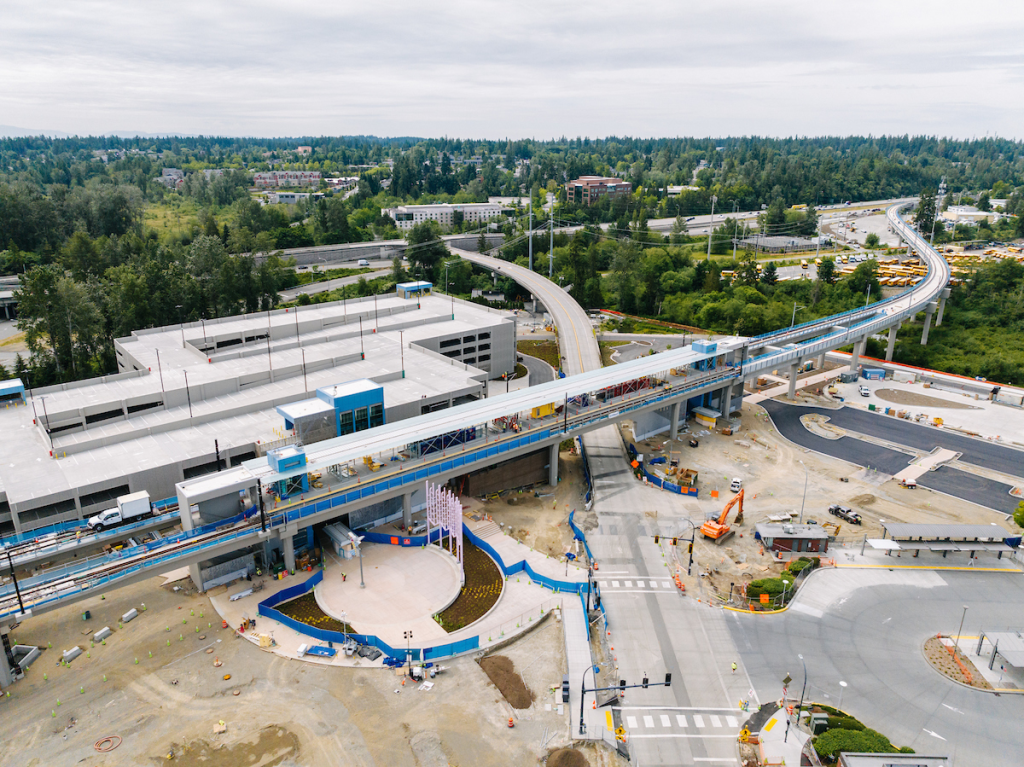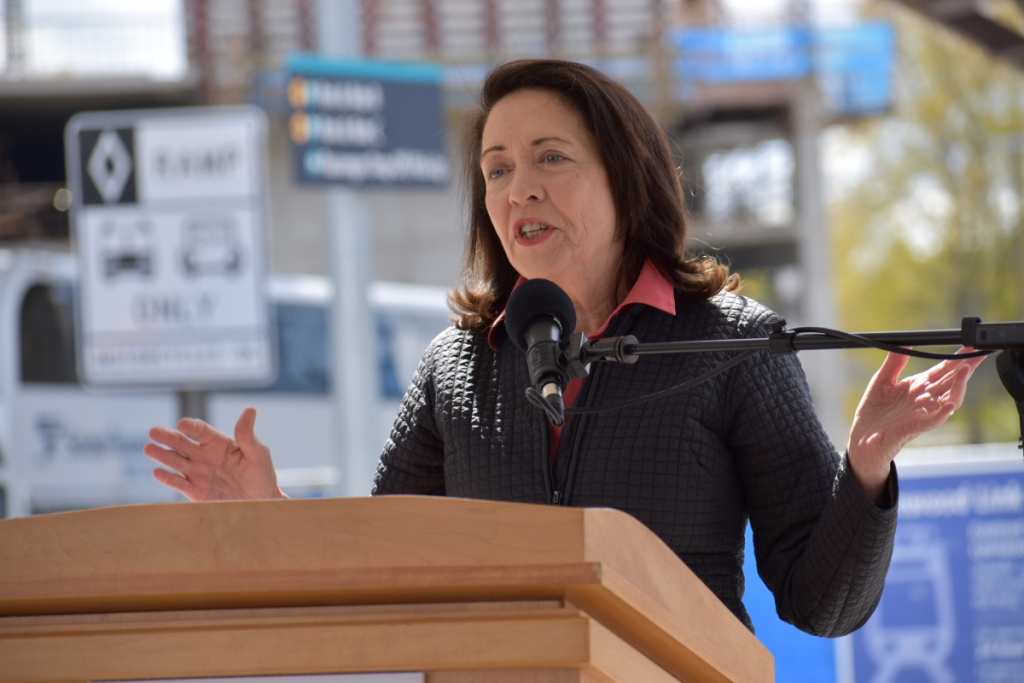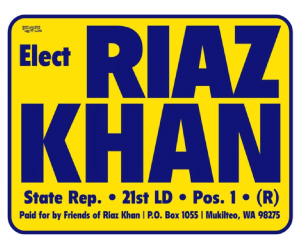WASHINGTON, D.C.—In his $4 billion funding recommendations for the Capital Investment Grants (CIG) Program and Expedited Project Delivery (EPD) Pilot Program, U.S. Transportation Secretary Pete Buttigieg included $88.4 million for the Lynnwood Link Extension that is expected to open by fall of 2024. This proposed funding would, if appropriated, complete the CIG grant agreement contribution toward the construction of the project.

According to the Federal Transit Administration, a total of $921.98 million in federal funding has been appropriated through Fiscal year 2023 towards Sound Transit’s Lynnwood Link Extension project.
“Sound Transit Light Rail is coming to Snohomish County, and that means more jobs and opportunity for Northwest Washington,” said Rep. Rick Larsen (WA-02), the lead Democrat on the House Transportation & Infrastructure Committee who recently met with Secretary Buttigieg on improving accessibility for members of the flying public with mobility issues. “The Lynnwood Link light rail extension, along with expanded bus service options from Sound Transit and Community Transit, are critical parts of connecting communities like Lynnwood, Mukilteo and Everett to Seattle and Tacoma. I will continue to work with Sound Transit, elected officials and community leaders to expand and improve light rail, reduce congestion and provide a reliable transit option for commuters in the Pacific Northwest.”
I just wrapped up a great meeting with @secretarypete & his team at the White House about protecting the safety, rights & dignity of air travelers with mobility issues. pic.twitter.com/1KHmBVaTyn
— Rep. Rick Larsen (@RepRickLarsen) February 29, 2024
In December of 2022, U.S. Senator Maria Cantwell (D-WA), who chairs the Senate Committee on Commerce, Science and Transportation, secured $254 million of in CIG funding for Lynnwood Link Extension in the Fiscal Year 2023 Omnibus Appropriations bill.
“Lynnwood Transit Station is already a central hub for riders to access reliable and convenient public transportation, and with Lynnwood Light Rail Station opening on the horizon, that access will be more critical than ever,” Senator Cantwell released in a statement on the opening of Sound Transit’s Transit Center Parking Garage in 2023 that will serve the Lynnwood Link Extension.

On April 17, 2023, Sound Transit opened the new parking garage at the Lynnwood Transit Center to serve current transit riders and future Link light rail riders. The new garage contains 1,670 parking stalls in a five-story structure. Along with adjacent surface lots containing 226 stalls, the Lynnwood City Center Station will have nearly 1,900 parking stalls, approximately 500 more stalls that are on the current transit center site.

Secretary Buttigieg traveled to Washington state in July of 2023 to highlight infrastructure investments from the Biden’s Administration’s Investing in America agenda that included nearly $100 billion from the Bipartisan Infrastructure Law to support transit agencies.

On Monday, March 11, Lynnwood Link Extension was one of 14 large transit projects in 11 states Secretary Buttigieg’s recommended that to receive nearly $4 billion in federal support for construction as part of President Biden’s Fiscal Year (FY) 2025 Budget Request to Congress.
“Public transportation connects people to jobs, school, family, and more – and when transit reaches more people and communities, its impact is even greater,” said U.S. Transportation Secretary Pete Buttigieg. “The Biden-Harris Administration is proud to support funding for 14 large projects that will expand transit for millions of Americans across the country.”
The Capital Investment Grants (CIG) and Expedited Project Delivery Pilot programs are the Federal government’s primary grant programs supporting new large transit capital projects that are locally planned, implemented, and operated. This includes investments such as new and expanded subway systems, commuter rail, light rail, streetcars, and bus rapid transit.

“FTA looks forward to working with these communities to advance transit projects that will provide new transit options,” said FTA Acting Administrator Veronica Vanterpool. “These investments support President Biden’s commitment to combat climate change while also improving safety, advancing equity, and improving quality of life for millions of Americans.”
Seven of the 14 recommended projects would receive funding recommendations through FTA’s Capital Investment Grants (CIG) program for the first time (see below), while others on the list are already under construction or far along in the process required to receive a capital construction grant. The projects, which require a local funding match, seek funding through FTA’s CIG and EPD Pilot programs.
The FY25 Annual Report on Funding Recommendations recommends $2.37 billion in annual appropriations requested from Congress and $1.6 billion in FY 2025 funding provided through the Bipartisan Infrastructure Law advance appropriations.
The President’s FY 2025 Budget request proposes funding for three projects in the CIG/EPD pipeline that were recommended in prior budgets but have not yet entered into a construction grant agreement:
- In Illinois, $350 million is recommended for the Chicago Red Line Extension Project to extend the Red Line Dan Ryan branch on Chicago’s Far South Side from the present 95th Street Terminal to the 130th Street area. The project will reduce commute times, improve mobility and accessibility, and foster economic development in a corridor with high levels of poverty, unemployment, and long travel times. The 5.6-mile extension includes the purchase of rail cars, stations, parking facilities and a new railyard and maintenance shop.
- In New Jersey/New York, $700 million is recommended for the proposed Hudson Tunnel Project to improve reliability for New Jersey Transit and Amtrak trains. The project includes construction of a new two-track heavy rail tunnel along the Northeast Corridor from the Bergen Palisades in New Jersey to Manhattan. The project includes the construction of a new tunnel under the Hudson River, the rehabilitation and modernization of the existing North River tunnel, and utility relocation work for the Long Island Railroad Emergency Services Building.
- In Texas, $109.7 million is recommended for the proposed VIA Advanced Rapid Transit North/South Corridor Project, a bus rapid transit project from the San Antonio International Airport in the north, through downtown San Antonio, to Steves Avenue in the south. It will connect key destinations along the corridor including North Star Mall, Baptist Medical Center, Missions National Historic Park, and numerous high-density commercial and residential areas. The project includes eight miles of dedicated transit lanes, stations, and the purchase of vehicles.
The President’s FY 2025 Budget request includes seven projects that are recommended to receive funding for the first time:
- In California, $200 million is recommended for the Inglewood Transit Connector Joint Powers Authority’s Inglewood Transit Connector Project, which will provide automated, elevated rail service to multiple large-event venues located along the project corridor and is intended to connect the underserved Inglewood community and the countywide passenger rail system. The project includes the construction of new rail tracks and stations and the purchase of vehicles.
- In California, $500 million is recommended for the Transbay Joint Powers Authority’s Transbay Downtown Extension Project, which will extend Caltrain commuter rail service from the China Basin/South Park neighborhood near the current Caltrain terminus to the Salesforce Transit Center in central San Francisco. The project is intended to improve public access to bus and rail service and accommodate projected growth in travel demand along the San Francisco Peninsula and South Bay corridor. The project includes 1.3 miles of underground tunnel, new rail tracks, stations, ventilation and egress systems, and the purchase of vehicles.
- In Florida, $263.7 million is recommended for the Miami-Dade County Department of Transportation and Public Works’ Northeast Corridor Rapid Transit Project, which will provide commuter rail service between Downtown Miami and the city of Aventura. The project is intended to improve multi-modal regional connections and increase transit options in an urban, commercial corridor. The 13.5-mile project includes stations, park- and-ride facilities, the purchase of vehicles and improvements to a rail yard and rail vehicle maintenance storage facility.
- In Indiana, $141.9 million is recommended for the Indianapolis Public Transportation Corporation’s (IndyGo) Blue Line Rapid Transit Project, which will implement bus rapid transit between the Indianapolis International Airport, downtown Indianapolis, and Cumberland along IndyGo’s busiest bus route, which serves a high concentration of low-income and zero-car households. The project includes 13.4 miles of dedicated transit lanes, stations and the purchase of diesel hybrid powered buses.
- In North Carolina, $138.3 million is recommended for the Chapel Hill Transit’s North-South Bus Rapid Transit Project, which will connect riders to several major activity and job centers, including the University of North Carolina at Chapel Hill, hospitals, and downtown Chapel Hill, and is intended to improve mobility and accessibility in the corridor’s low-income communities. The project includes 5.7 miles of exclusive bus lanes, stations, and the purchase of vehicles.
- In Texas, $134.7 million is recommended for the VIA Metropolitan Transit’s Advanced Rapid Transit East/West Corridor Project, which will provide bus rapid transit connecting key destinations, including the Alamo, the San Antonio Riverwalk, the University of Texas San Antonio Downtown Campus and downtown San Antonio. The project will serve a corridor with a high proportion of low-income and zero-car households, older adults, people with disabilities and minority groups. It includes 5.1 miles of dedicated transit lanes, stations, and the purchase of low- or no-emission vehicles.
- In Wisconsin, $118.1 million is recommended for the city of Madison’s North-South Bus Rapid Transit Project, which will connect neighborhoods north of Madison, through downtown, and into the city of Fitchburg. The BRT project will provide access for underserved communities and low-income populations and link them to employment opportunities and healthcare facilities. The project includes 5.2 miles of exclusive bus lanes, stations and the purchase of battery electric buses.
The President’s FY 2025 Budget request also proposes funding for four projects with existing construction grant agreements:
- In California, $315.7 million is recommended for the Westside Purple Line Extension Section 3 Rail Project. The Westside Subway provides a critical connection for the region’s second-largest job center and connects downtown Los Angeles with the Westside.
- In Minnesota, $129.5 million is recommended for the Minneapolis Southwest Light Rail Transit Project. The Southwest Light Rail adds 14.5 miles to the existing METRO Green Line and connects downtown Minneapolis, downtown Saint Paul, St. Louis Park, Hopkins, Minnetonka, and Eden Prairie.
- In New York, $496.8 million is recommended for the New York City Second Avenue Subway Phase 2 project. The subway extension will provide transit access in Manhattan to East Side residents, workers, and visitors, and improve mobility for all New Yorkers.
- In Washington, $88.4 million is recommended for the Seattle Lynnwood Link Light Rail Extension Project. This project will extend the light rail system from Northgate station in King County to the Lynnwood City Center Station in Snohomish County and is intended to relieve congestion, improve transit performance, and enhance mobility choices.
In the President’s FY 2025 Budget, FTA also proposes several provisions to increase access to and the effectiveness of federal funds across communities:
- Support equity in rural and Tribal areas: Waive the match requirement for rural, tribal, and non-profit providers in the Enhanced Mobility of Seniors and People with Disabilities and Formula Grants for Rural Areas programs, and waive the match requirement for Tribal applicants to the Buses and Bus Facilities and Low-and No Emission competitive programs;
- Address the fiscal cliff: Allow Urbanized Area Formula Funds and Federal Highway Administration “flex funds” to be used for operating assistance in all urban areas;
- Empower local authorities: Enable transit agencies to purchase real property outside an existing transit corridor, harmonizing with Federal Highway Administration policies;
- Unlock micromobility systems: Allow FTA grantees to directly fund shared micromobility systems, such as bicycles and scooters, to enhance connectivity to transit stations; and
- Lower bus costs and speed up delivery: Authorize FTA to encourage lower costs and faster delivery of low- and no-emission buses, such as through standardized purchases.




















6 Responses
With all due respect, why you people keep throwing billions of tax payers dollars at a failed transit system is mind boggling, you simply should have copied the Skytrain system in Vancouver Canada and you’d have 5 times the ridership ship.
Failed? I’m glad you like your’s, but ours is not finished and I can get from Everey to Seattle without a car.
This transit project isn’t going anywhere. It’s all lip service and nothing is happening with the project. Meanwhile plenty of people pay too much for their car tabs that most likely won’t be needing to use the light rail system once it’s up and running. Someone mentioned the skytrain in Canada and that’s a very good light rail system. I have actually used it and I admire the work they did on their light rail skytrain.
I am baffled by people claiming it is a hoax. I can see the rail lines every time I drive down I-5, I drive by the station often, hell I even saw a train doing a test run. The rumors are it’s going to soft open in the next week or so.
Too bad it was built “on the cheap,” relatively speaking, for the train from downtown to Sea-Tac doesn’t even reach 40 mph until just before it turns south at the north end of Tukwila. Airport trains go faster than that! And, the 1 Line is besieged with single-tracking and delays, with no bus alternative, whether it be the wonderful 194 express that King County Metro used to provide – arriving at Sea-Tac 2 minutes faster than rail in testing, or going northbound from downtown after events, leaving riders waiting downtown at 11 pm at night, at times up to 30 minutes for the next train. Meanwhile, Community Transit should be providing exceptional service rather than using its Puget-Sound leading transit sales tax (1.2%) and fares on expensive TV and social media commercials for a ridership representing less than 5% of commuters. King County Metro (0.9%), Pierce Transit (0.6%), and Everett Transit (0.6%) spend their money on safety, providing service, and rider amenities like benches, lighting, braille and audio support for their maps, and signage.